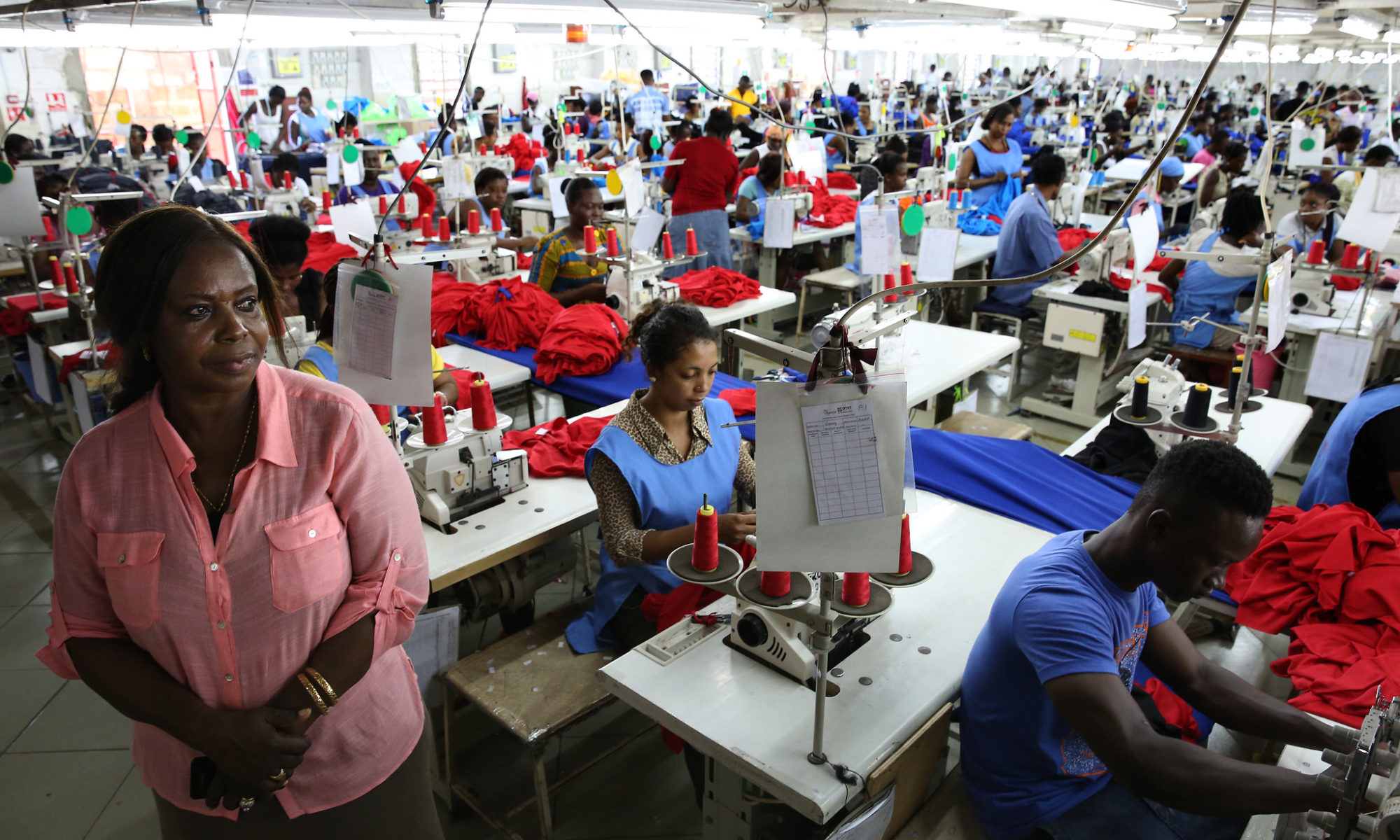By Karin Fischer, Christian Reiner and Cornelia Staritz
Countries of the Global South and particularly lower-income countries could barely benefit from the integration into global value chains (GVCs) so far. Regional integration, ecological leapfrogging, development-oriented macroeconomic policies and certain global framework conditions are necessary to distribute the benefits from (and costs of) GVCs more broadly.
While the expansion of GVCs started in the 1960’s with the outsourcing and offshoring of labour-intensive production steps, it accelerated in the period of hyperglobalization in the 1990s and 2000s. The main drivers were liberalization policies, a focus on export-oriented development strategies combined with information technologies and container transport. Since 2008 the expansion seems to have come to a temporary end. Particularly geopolitical tensions and aspirations for strategic autonomy by key economic powers could prolong this “slowbalization”, albeit at a high level.
Figure 1: Development of GVCs, 1970-2015

Source: World Bank 2020.
The development impulses of GVCs for countries of the Global South depend on the way firms and regions are integrated. The more competences and capabilities producers in the Global South can acquire, and the more they also become available for local firms through local linkages and value capture, the more likely are positive development and employment effects. However, as such processes do not happen automatically through markets due to externalities or uneven power relations, industrial policy is needed.
Different types of industrial policy
In the past two decades, two strategies that both emphasize the advantages of world market integration have been predominant. From the perspective of liberal industrial policy, industrial policies shall primarily establish conditions for the efficient functioning of markets. According to this position, the increasing relevance of imported intermediate products for national economies and firms requires even further trade liberalization. Further elements of such policy – as favoured, for instance, by the World Bank and the OECD – are investments in infrastructure and education, stability of the law as well as special economic zones which provide beneficial conditions especially for foreign investors.
In comparison, the mainstream position of GVC research emphasizes the importance of lead firms, largely transnational companies from the centres of the world economy and upgrading of supplier firms in the Global South. Lead firms control GVCs through setting standards and requirements and awarding production orders. These firms often focus on research, design and marketing and outsource particularly production with lower added value to supplier firms in the Global South. Their strategies determine the possible learning effects of supplier firms and can facilitate, but also prevent, their upgrading. According to this strategy, industrial policy should actively shape the relations between lead firms and local firms with the objective of improving the position of local firms in GVCs. This upgrading can relate to fabricating products of higher quality, initiating more efficient processes, or moving to higher-value functions.
Higher-income countries profit, not lower-income countries
The consequences related to these policy strategies are, however, highly ambivalent, and countries of the Global South have benefited very unevenly from GVCs. A study of the International Monetary Fund covering 189 countries in the period from 1990 to 2013 comes to the conclusion that especially high-income and upper middle-income countries benefited from GVCs, while no positive effects were shown for low- and lower middle-income countries. A study of the Groningen Growth and Development Centre shows that GVC integration leads to very uneven and selective results within individual countries: Only a very small group of highly productive firms profits with no or even negative employment effects.
Due to uneven power relations, companies from the Global North were able to increase their profits in GVCs. The opposite pertains to their supplier firms: The higher the participation in GVCs (via forward participation), the lower the profits. This hampers investments and upgrading and increases pressures on wages and working conditions. Besides low learning and value capture effects for supplier firms, tax evasion strategies facilitated by GVCs result in fiscal problems of supplier countries.
These results are not entirely surprising. The UNCTAD already ascertained in an investigation on the integration of least developed countries (LDCs) in 24 commodity chains in 2007 that downgrading occurred in half of these countries in the period from 1995 to 2005, i.e. the position of firms worsened in GVCs. Upgrading only took place in seven cases. That the age of GVCs only brought very selective advantages is also shown in industry statistics. According to table 1, particularly LDCs in Africa suffer from early deindustrialization and de facto don’t play any role in global industrial production. This is problematic, since there is no tested development model without industrialization at least until now.
Table 1: The importance of manufacturing

Source: UNIDO MVA 2020 Database, UNCTADSTAT, own calculations
A development-oriented global framework
Dependent integration into GVCs with limited learning and value capture effects, and the focus on the production of goods without local and regional demand, absorb scarce resources that are required for structural transformation. These should instead be used for developing local productive capacities, which could happen through a mix of integration into, but also selective de-coupling from world markets. Regional integration can constitute a promising strategic complement. Interregional trade in Africa as well as in Latin America is characterized by a technologically more demanding and more diversified product structure. Apart from the stronger orientation towards goods that are more likely to be demanded in domestic markets, the export to less demanding markets brings along further advantages: older machinery which is more likely to be available in the region can be used, and upgrading to higher-value activities can be easier.
Furthermore, more localized and regional production systems are more likely to respect the ecological limits of the planet. Even though the burden of structural adjustment in the context of socio-ecological transformation must be primarily taken over by higher-income countries, ecological leapfrogging in the Global South implies an infrastructure for renewable energies and an eco-efficient public transport system, as well as an industrial policy that supports sustainable agricultural and industrial systems of production.
Even a well-conceived industrial policy will fail without supporting macroeconomic policies. What’s needed is on the one hand a low-interest rate policy that stimulates productive investments and innovation, and on the other hand a stable exchange rate that rather tends towards undervaluation. Commodity price bubbles and speculative capital inflows lead to overvalued currencies and reduce the price competitiveness of export firms. In terms of fiscal policy, luxury consumption and non-essential or non-productive imports should be taxed higher in order to generate leeway for productive investments.
Given the massive inequalities along GVC, there is also need for action on a global level. The economic and political power of transnational companies has increased massively over the past decades. Competition authorities in Africa, Asia and Latin America are often incapable to control these companies. Therefore, Korniek and Stiglitz propose the establishment of a supranational competition authority, for instance for LDCs. Such an agency would provide an opportunity to reduce economic exploitation and could also enforce the compliance with social and environmental standards. Furthermore, globally co-ordinated company taxation to prevent tax avoidance and increase public revenues is required. Lastly, reorganizing international trade and investment policy centred around increasing policy space for lower-income countries for the implementation of trade and industrial policy favourable to development is needed. This also includes new regulations in the area of intellectual property rights. Results of public research should not be patented, whereas weaker patent protection for lower-income countries regarding private research seems reasonable.
This blog is an adapted translation of a German blog published in Ökonomenstimme: It is based on a chapter in “Globale Warenketten und Ungleiche Entwicklung – Arbeit, Kapital, Konsum, Natur” (Global commodity chains and uneven development – Labour, capital, consumption, nature) edited by Karin Fischer, Christian Reiner and Cornelia Staritz:
Note: This article gives the views of the authors, not the position of the EADI Debating Development Blog or the European Association of Development Research and Training Institutes.
Karin Fischer teaches global sociology at the Institute of Sociology at Johannes Kepler University, Linz.
Christian Reiner is Senior Lecturer and Head of Research at the Lauder Business School, Vienna.
Cornelia Staritz is Tenure Track Professor in Development Economics at the Department of Development Studies at the University of Vienna.
Image: World Bank Photo Collection under a creative commons licence on Flickr

